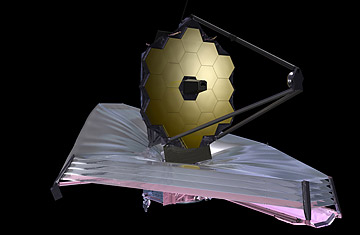
A September 2009 artist conception of James Webb Space Telescope
When last we heard about the James Webb Space Telescope, the souped-up, long-planned successor to the Hubble, the news was not good. Hard on the heels of a report blasting the Webb project for being badly behind schedule and over budget, a House committee voted to axe the partially completed telescope entirely.
Even a space nut could appreciate where they were coming from: originally envisioned in the 1990s as a monster scope 26 ft. (8 m) across, with more than 17 times the light-gathering power of the Hubble, the Webb was going to cost no more than $500 million and launch by 2007 — cross NASA's heart and hope to die! No one really bought that, but no one really expected the budget to swell to $2.6 billion and then to $6.2 billion, or the launch date to slip to 2015 and then 2018 either. When all that did happen, D.C. bean counters concluded that nothing would become the Webb project quite as much as the end of it.
Fortunately for science, though, the rumors of the project's death were greatly exaggerated. Congress ended up funding the Webb after all, and in a telephone call the other day, Scott Willoughby, the Webb program manager at Northrop Grumman (the contractor that's building the telescope for NASA), reported that the slow, meticulous process of building the most powerful stargazing instrument in history is moving steadily ahead. "In terms of the things we said we'd accomplish by now," he says, "we're on track, and in some areas, we're actually ahead of schedule."
The most significant of these milestones, says Willoughby: "We've completed — and that's a big word — all 18 segments of the primary mirror, which have been in production for seven or eight years now." Unlike the Hubble's big light-gathering mirror, the Webb's can't be made in one piece. That's because no rocket exists that can hold something so wide. Instead, the mirrors, made of beryllium metal with a microscopically thin coating of gold, will unfurl in space like flower petals to reach their full size. Back in December, the gold was applied, and the mirrors were being readied for testing in a cryogenic test chamber at the Marshall Space Flight Center in Huntsville, Ala. That test is a critical one since engineers need to know the material can survive the frigid conditions in deep space.
For the Webb, cold isn't just an obstacle: it's a necessity if the telescope is going to work. Astronomers have learned that many of the biggest unanswered questions of their field — How and when did the very first stars appear? How were the galaxies assembled from those stars? How do planets form? Does the chemistry of distant planets' atmospheres suggest the existence of life? — are best answered by looking in infrared, not visible light. To detect the faint glow of infrared, a telescope works best if it's as cold as possible, so that heat from the telescope itself doesn't contaminate the signal. In space, that's no problem.
It isn't, anyway, if the telescope can be shielded from the heat of the sun — and even from the faint heat given off by the earth. To accomplish that, the Webb will sit atop a sunshield, about the size of a tennis court. The shield, which always stays between the Webb on one side and the sun, moon and earth on the other, is made of five layers, separated by a bit of empty space for extra cooling.
Given that it's even bigger than the telescope itself, the sunshade will have to unfold in space as well. So the entire assembly — telescope, mirrors, sunshade and scientific instruments — will be unfolded on the ground for testing, and that will happen more than once. "We'll deploy each component several times as we assemble," says Willoughby, "and then the entire observatory will be stowed and deployed." It will also be shaken to simulate the rigors of launch, in a chamber originally built to test the Apollo spacecraft. "Deploy, shake, deploy," says Willoughby. "This is space. It has to work the first time."
That's all the more true because while the Hubble zips along just 300 miles (483 km) above the earth's surface, the Webb will sit closer to a million miles (1.6 million km) away, at a spot known as Lagrange Point 2, or L2. From that stable spot, where the gravity of the earth, moon and sun effectively cancel one another out, the three bodies also remain in the same direction relative to the telescope all the time, making the sunshield's cooling job easier. Simplicity and reliability are essential, because unlike the Hubble, the Webb will hardly be within reach of any astronaut repair crews.
Assuming the next six years go smoothly, the Webb telescope will undoubtedly revolutionize astronomy when it goes up in 2018. It is, however, a mixed blessing: the mission's voracious appetite for money has sucked funding from other space-science projects, and NASA is expected to announce more cuts as early as this week. Once those spectacular images start rolling in, though, it will be hard to argue that the James Webb Space Telescope was ever worth canceling.
